|
A Museum of the Sacred
by Bob
Brooke
As you enter the
Great Hall of the Glencairn Museum, your eyes drift upward to the
magnificent vaulted beamed ceiling. From there your gaze drifts to
the vibrant stained glass windows and finally rests on the
spectacular three-story arch covered in glass mosaics. While
Glencairn isn’t, itself, designed in the Art Deco style, it contains
many ancient objects and motifs which influenced designs and
architects of the 1920s and 1930s.

Raymond Pitcairn, the eldest child of John and Gertrude Pitcairn, was
born in Philadelphia in 1885. At the age of 10, he moved with his family
to Cairnwood, their newly completed home in the New Church community
named Bryn Athyn. Pitcairn attended the Academy of the New Church
schools and later received a law degree from the University of
Pennsylvania. He married Mildred Glenn in 1910.
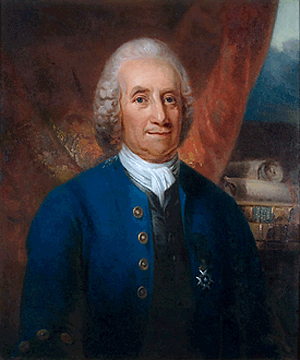 The
Pitcairns were members of the New Church, based on the teachings of
Emanuel Swedenborg. The followers of Swedenborg established a church in
Philadelphia in 1817 which they called the New Church. But after
visiting the bucolic countryside of Huntingdon Valley north of the city,
they decided to move their church to the area. They settled in what
would later become Bryn Athyn. Here they built buildings to house the
schools of the Academy of the New Church, which they had previous
founded in Philadelphia, as well as a magnificent Gothic cathedral. The
Pitcairns were members of the New Church, based on the teachings of
Emanuel Swedenborg. The followers of Swedenborg established a church in
Philadelphia in 1817 which they called the New Church. But after
visiting the bucolic countryside of Huntingdon Valley north of the city,
they decided to move their church to the area. They settled in what
would later become Bryn Athyn. Here they built buildings to house the
schools of the Academy of the New Church, which they had previous
founded in Philadelphia, as well as a magnificent Gothic cathedral.
By the time construction began on Bryn Athyn Cathedral in 1913, Raymond
Pitcairn was already heavily involved in the project. A lawyer by
profession, Pitcairn was also a self-taught architect.
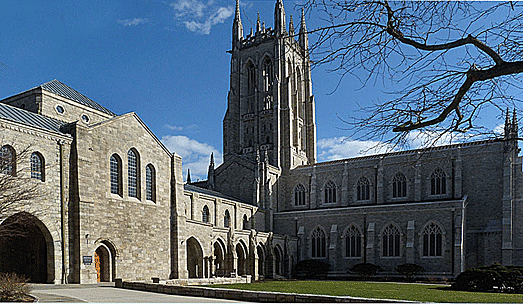
Pitcairn began collecting medieval art in 1916, originally to provide
inspirational examples for the craftsmen producing stained glass windows
and sculptures for the new cathedral. Although his interest lay more in
architecture than art collecting, by 1922 the size of the collection had
outgrown Pitcairn’s home, Cairnwood, and Pitcairn began planning a new
building. Over the next few years, his initial concept of a "cloister
studio" developed into a plan for a Romanesque-style “castle,” located
on a flat piece of ground adjacent to Cairnwood.
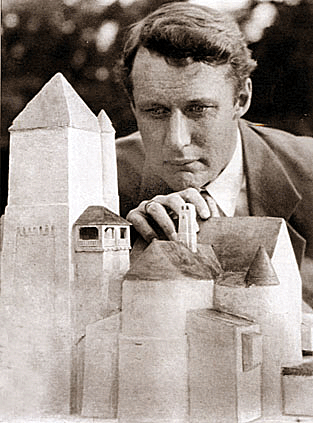 Pitcairn
and his design team carefully planned how to incorporate his favorite
works of art into the structure of the building. He had a scale model of
Glencairn's Great Hall made so that objects could be tested in a variety
of locations until they seemed to be in harmony with their new
surroundings. After many years of design and construction, the Pitcairns,
moved into Glencairn, their new home, in 1939. Pitcairn
and his design team carefully planned how to incorporate his favorite
works of art into the structure of the building. He had a scale model of
Glencairn's Great Hall made so that objects could be tested in a variety
of locations until they seemed to be in harmony with their new
surroundings. After many years of design and construction, the Pitcairns,
moved into Glencairn, their new home, in 1939.
Pitcairn built Glencairn in a style based on medieval Romanesque
architecture, but incorporated elements of medieval Gothic buildings in
it as well. The design of the building evolved gradually, using scale
and full-sized models rather than relying exclusively on predetermined
architectural plans.
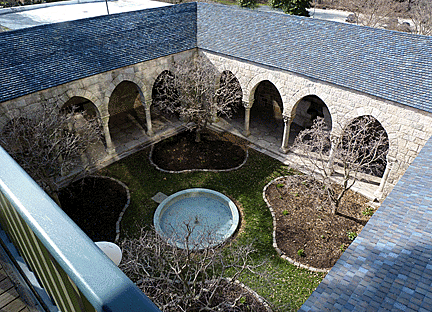 The
work of George Grey Barnard, the American sculptor and medieval art
collector who in 1914 opened his Cloisters Museum in upper Manhattan,
greatly influenced the design of Glencairn. It was here that Pitcairn
saw how Barnard had incorporated art into the interior of his museum. The
work of George Grey Barnard, the American sculptor and medieval art
collector who in 1914 opened his Cloisters Museum in upper Manhattan,
greatly influenced the design of Glencairn. It was here that Pitcairn
saw how Barnard had incorporated art into the interior of his museum.
As with Bryn Athyn Cathedral, Pitcairn insisted that all the elements of
Glencairn be produced on site in workshops originally built for artisans
who worked on the cathedral.
Artisans produced intricate mosaic designs based on the Book of Kells, a
medieval manuscript written about 800 A.D., for the ceiling trusses in
the Great Hall and featuring quotations from the theological works of
Swedenborg.
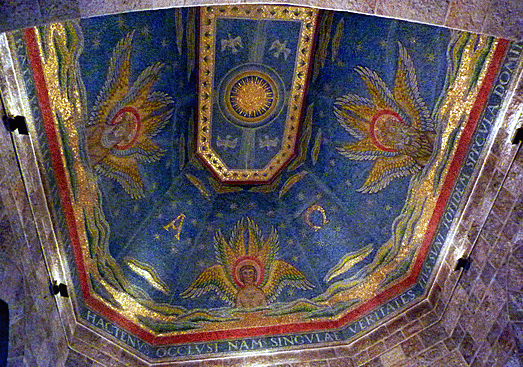
Originally, Pitcairn built Glencairn as a home for his family. The name
is a blend of the family names of Raymond Pitcairn and his wife, Mildred
Glenn. They had nine children. He designed the Great Hall to display an
art collection, but above all else he intended Glencairn to be a home.
In addition to medieval art, Glencairn contains a wealth of original art
in stone, wood, glass, and mosaic created by Bryn Athyn craftsmen and
inspired by New Church beliefs. The major decorative themes are
variations of one of the Bible's most repeated commands, "You shall love
your neighbor as yourself." Symbols of the four communities the
Pitcairns hoped to serve during their lifetimes—family, school, country,
and church—can he found throughout the building.
The Theme of Family
The theme of family appears many times in the decoration of Glencairn,
usually represented by sheep and lambs.
Music was an important part of the life of the Pitcairn family. Pitcairn
had images of his children with their musical instruments carved on
large corbels supporting a balcony on the south wall of Glencairn's
tower.
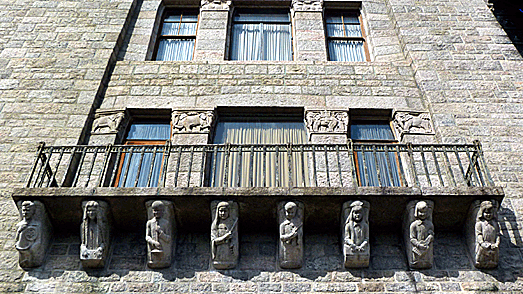
Other quotes from New Church teachings appear all over the house.
Pitcairn designed the monumental arch covered in glass mosaic which
extends up to the third-floor balcony of the Great Hall. The subject of
the mosaic is the school seal, which consists of four medallions
surmounted by a crowned seated lion. Each medallion represents one of
the tour schools of the Academy of the New Church—the Boy’s School, the
Girls School, Bryn Athyn College, and the Theological School.
Pitcairn’s Art Collection
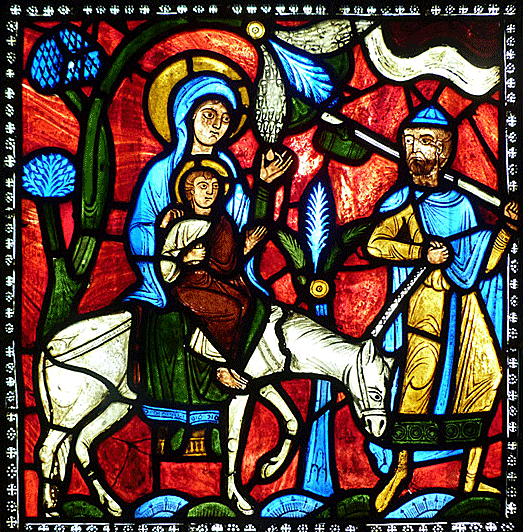 In
addition to Christian art, Raymond Pitcairn acquired art from ancient
Egypt, the Ancient Near East, ancient Greece and Rome, and a few objects
from Asian and Islamic cultures, all related to the religion of each
culture. The jewel of his collection of medieval stained glass is a
colorful 13th-century panel depicting a king from the Tree of Jesse
Window at Soissons Cathedral in France. The subject is the royal
genealogy of Jesus Christ. In
addition to Christian art, Raymond Pitcairn acquired art from ancient
Egypt, the Ancient Near East, ancient Greece and Rome, and a few objects
from Asian and Islamic cultures, all related to the religion of each
culture. The jewel of his collection of medieval stained glass is a
colorful 13th-century panel depicting a king from the Tree of Jesse
Window at Soissons Cathedral in France. The subject is the royal
genealogy of Jesus Christ.
Touring the Museum
You’ll begin your tour in the Great Hall. After viewing the medieval
statuary, tapestries, mosaics, and stained glass windows there, you’ll
move up to the top of the tower by elevator for a panoramic view of Bryn
Athyn. From here, you’ll work your way down by stairs floor by floor,
viewing galleries along the way.
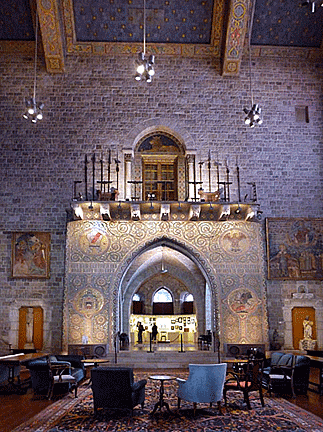 You’ll
first visit the family chapel on the fifth floor, with its beautiful
stained glass windows. The decorative art work on the stairway is
stylized Egyptian and Islamic motifs. As you enter the chapel, you’ll
immediately be drawn to the stained glass windows on either side, one
showing the Christmas story and the other the Easter story. Then you’ll
gaze upwards to the mosaic ceiling. You’ll
first visit the family chapel on the fifth floor, with its beautiful
stained glass windows. The decorative art work on the stairway is
stylized Egyptian and Islamic motifs. As you enter the chapel, you’ll
immediately be drawn to the stained glass windows on either side, one
showing the Christmas story and the other the Easter story. Then you’ll
gaze upwards to the mosaic ceiling.
On the floor below is the Egyptian Gallery in what once was the bedroom
of one of Pitcairn’s daughters. Pitcairn organized the objects in
Glencairn's Egyptian Gallery around religious themes like Egyptian gods,
mythology, and mummification. Miniaturized dioramas illustrate Egyptian
beliefs about the afterlife. One diorama, The Embalmer's Art: Mummy,
Myth, Magic, shows a large embalmer's workshop at the end of the New
Kingdom. Mummification was primarily a religious ritual that re-enacted
the myth of Osiris, a legendary king who his
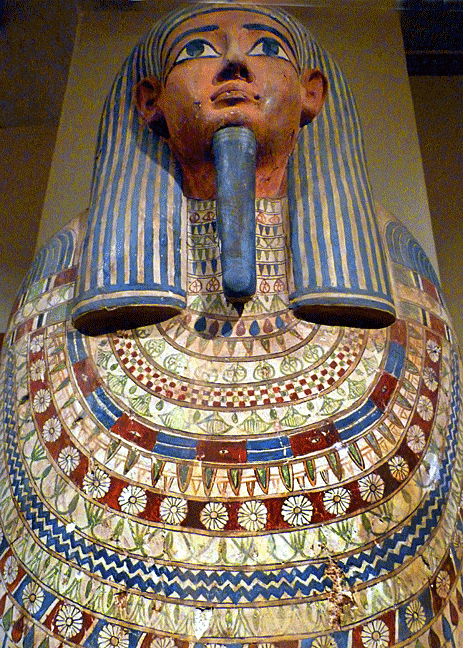 brother
Seth murdered and dismembered. Osiris was later re-assembled, wrapped
with bandages, and magically revived to become the ruler of the dead.
Similarly, each Egyptian man and woman hoped to become an "Osiris" in
the next life through the process of mummification. A highlight of this
gallery is a handpainted cover for a mummy. brother
Seth murdered and dismembered. Osiris was later re-assembled, wrapped
with bandages, and magically revived to become the ruler of the dead.
Similarly, each Egyptian man and woman hoped to become an "Osiris" in
the next life through the process of mummification. A highlight of this
gallery is a handpainted cover for a mummy.
As you enter the smaller of the medieval galleries, a former bedroom of
one of Pitcairn’s sons, you immediately notice the brilliance of the
authentic French stained glass embedded into the far wall. The pieces
came from the Abby of St. Denis and include “The Flight into Egypt” and
a king with soldiers on horseback. The centerpiece of the Medieval
Gallery is a carved 15th-century choir stall from coastal Spain. Over
600 pieces of medieval art make up the largest and most important
collection in Glencairn. It consists of mostly French sculpture and
stained glass from the years 1100 to1300. There are also ivories,
enamels, manuscripts, tapestries and frescos. Besides two medieval
galleries, Glencairn has many works of medieval art installed in the
Great Hall.
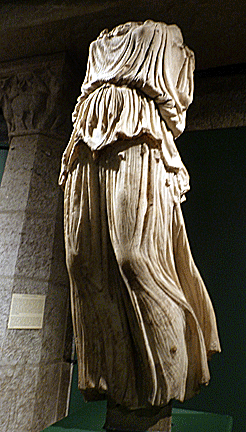 Glencairn
has two classical galleries, one for Roman and the other for Greek
antiquities, together showcasing some of the collection’s 500 artifacts.
The most spectacular piece is a nearly life-sized marble statue of
Minerva Victoria, an eye-catching and well-preserved Roman statue of the
goddess Minerva in the guise of Victory from Cyrene in modern-day Libya. Glencairn
has two classical galleries, one for Roman and the other for Greek
antiquities, together showcasing some of the collection’s 500 artifacts.
The most spectacular piece is a nearly life-sized marble statue of
Minerva Victoria, an eye-catching and well-preserved Roman statue of the
goddess Minerva in the guise of Victory from Cyrene in modern-day Libya.
You’ll also visit the library with its massive vaulted beam ceiling.
Adjacent to the library is the master bedroom, left as the Pitcairns had
used it with its handcarved bed. The teakwood bed, handcarved by Frank
Deck, has words, adapted from a New Church marriage service, "Unite our
hearts in love to one another and to Thee. Give us one heart, one mind,
one way. Grant us knowledge to see Thy way and power to do Thy will,"
inscribed around its base.
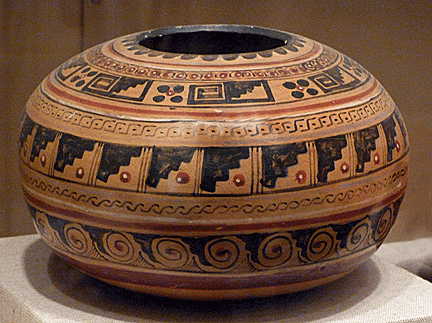 Glencairn's
American Indian Gallery includes artifacts from tribes in Mesoamerica,
the Northwest, the Southwest, the Plains, the Eastern Woodlands, and the
Inuit areas. Though the oldest pieces date from 3,000 to 1,000 BC, most
date from the late 19th and early 20th centuries. While several objects
have special religious significance, many of the common objects on
display illustrate the way that religion permeated the lives of Native
Americans. Glencairn's
American Indian Gallery includes artifacts from tribes in Mesoamerica,
the Northwest, the Southwest, the Plains, the Eastern Woodlands, and the
Inuit areas. Though the oldest pieces date from 3,000 to 1,000 BC, most
date from the late 19th and early 20th centuries. While several objects
have special religious significance, many of the common objects on
display illustrate the way that religion permeated the lives of Native
Americans.
The Ancient Near East Collection contains artifacts of significance to
the history of religion. Smaller pieces include cuneiform tablets,
cylinder seals with images of deities, and votive objects dedicated at
shrines and temples. The cuneiform tablets, foundation cones, and a
large foundation cylinder describing the rebuilding of the walls of
Babylon by Nebuchadnezzar are just some of the important items.
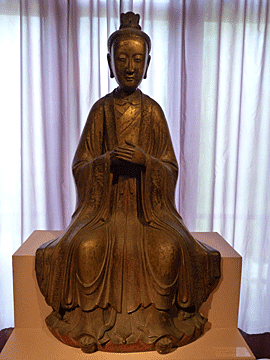 The
museum’s Asian collection features 30 works of art from China, with a
few from Japan and Thailand. Ranging from the Chinese Han Dynasty from
25-220 A.D. to the 19th century, the objects reflect the beliefs and
values of East Asian Mahayana Buddhism as well as elements of
traditional Chinese culture with its Confucian and Taoist influences. A
highlight of the gallery is a large Chinese bronze sculpture of a seated
Taoist sage from the Ming Dynasty, dating from 1368-1644 A.D., who has
understands the operation of the Tao, meaning "the Way," as it appears
in nature, then incorporates this into his life. The
museum’s Asian collection features 30 works of art from China, with a
few from Japan and Thailand. Ranging from the Chinese Han Dynasty from
25-220 A.D. to the 19th century, the objects reflect the beliefs and
values of East Asian Mahayana Buddhism as well as elements of
traditional Chinese culture with its Confucian and Taoist influences. A
highlight of the gallery is a large Chinese bronze sculpture of a seated
Taoist sage from the Ming Dynasty, dating from 1368-1644 A.D., who has
understands the operation of the Tao, meaning "the Way," as it appears
in nature, then incorporates this into his life.
Raymond Pitcairn collected mostly European furniture, including Windsor
chairs, tables, storage chests, and desks which sit in prominent places
throughout the museum. In addition, Glencairn contains over 200 antique
oriental rugs, including village
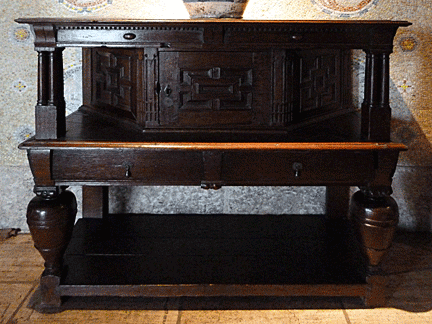 and
tribal rugs, as well as prayer rugs. The decoration of prayer rugs is
rich in Islamic symbolism, including symbols from religions that existed
in the ancient Near East before Islam. The "mihrab" is an arch that
points toward the Holy City of Mecca. Both the rug and the worshiper
praying on it are required to point toward Mecca. In Islamic tradition
this arch represents the "gateway to paradise." The symbol of an arch as
a gateway to paradise has its origin in ancient Mesopotamian symbolism,
which predates Islam by several millennia. and
tribal rugs, as well as prayer rugs. The decoration of prayer rugs is
rich in Islamic symbolism, including symbols from religions that existed
in the ancient Near East before Islam. The "mihrab" is an arch that
points toward the Holy City of Mecca. Both the rug and the worshiper
praying on it are required to point toward Mecca. In Islamic tradition
this arch represents the "gateway to paradise." The symbol of an arch as
a gateway to paradise has its origin in ancient Mesopotamian symbolism,
which predates Islam by several millennia.
New Church Art
Glencairn Museum also has a growing collection of New Church or
Swedenborgian. A plaster relief sculpture titled "Deliver Us From Evil"
was made in about 1805 by the well-known British artist, John Flaxman
(1755-1826). This depiction of two good and two evil spirits struggling
for control of the human soul illustrates the New Church concept of
spiritual freedom. Flaxman was the first artist to depict the deceased
human soul as a full-bodied adult, an idea derived directly from
Swedenborg. Together with "Thine is the Kingdom," a companion piece also
in Glencairn's collection, this preliminary model was later executed in
marble for a family tomb monument in England.
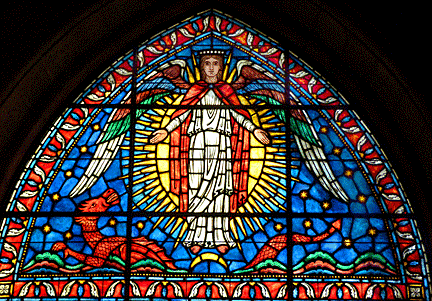
Only a portion of the galleries are regularly open to the public by
conducted tour, but the museum sponsors two weekend-long festivals, a
spiritual arts festival in April and a medieval festival in November, at
which time all the galleries are open.
<
Back to More Antiques to View
Next Article > |
